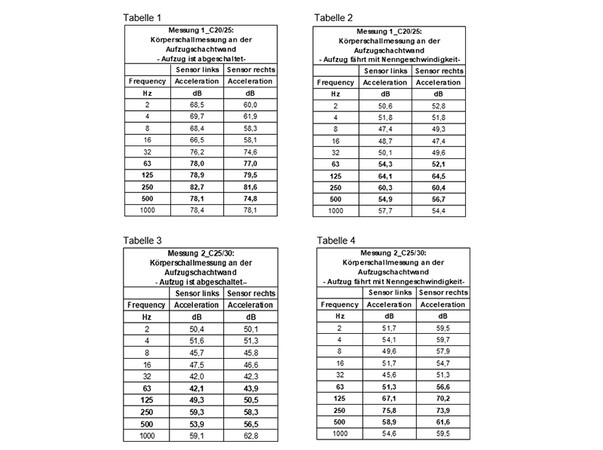This is how concrete influences noise transmission
As already indicated in the last article to this topic, the quality of concrete has a decisive influence on structure-borne noise emission. This relationship is described in this article.
By Ulrich Nees and Jan König
The main focus in DIN 8989 / Table 4 "Noise insulation in buildings – lifts" is on surface-related mass of walls and ceilings to be observed to meet the noise insulation targets. The subject of the pressure-resistance class of the concrete DIN EN 206, DIN 1045-2 and DIN EN 13791 for lift shafts is absent.
First, a few foundations: the strength of the concrete is determined after 28 days with a cylinder with a diameter of 150 mm and a length of 300 mm (fck,cyl) or a cube with 150 mm edge length (fck,cube). The pressure resistance class C 20/25 corresponds to 20 N/mm² for fck,cyl and C 25/30 to 25 N/mm² for fck,cube.
"Natural" vibration of the lift shaft
In DIN 8989, a reference and calculation basis is missing, among other things, for determining what influence the "vibration" of the lift shaft has on the structure-borne noise insulation when the lift is shut down. Third-party noises must be considered when evaluating the airborne noise level (1) emitted. The airborne noise level, which arises from the "natural" vibration of the lift shaft or building, is not considered.
 Table 1: Measurement 1_C20/25: Structure borne noise measurement on the lift shaft wall. Lift is shut down. / Table 2: Measurement 1_C20/25: Structure-borne noise measurement on the lift shaft wall. Lift travelling at rate speed. / Table 3: Measurement2_C25/30: Structure-borne noise measurement on the lift shaft wall. Lift is shut down. Sensor left. Sensor right. / Table 4: Measurement2_C25/30: Structure-borne noise measurement on the lift shaft wall. Lift travelling at rated speed. Sensor left. Sensor right. Photo: © Ulrich Nees / Jan König
Table 1: Measurement 1_C20/25: Structure borne noise measurement on the lift shaft wall. Lift is shut down. / Table 2: Measurement 1_C20/25: Structure-borne noise measurement on the lift shaft wall. Lift travelling at rate speed. / Table 3: Measurement2_C25/30: Structure-borne noise measurement on the lift shaft wall. Lift is shut down. Sensor left. Sensor right. / Table 4: Measurement2_C25/30: Structure-borne noise measurement on the lift shaft wall. Lift travelling at rated speed. Sensor left. Sensor right. Photo: © Ulrich Nees / Jan KönigThe following tables (1 to 4) show structure-borne noise emissions that were carried out at the same measurement points according to DIN 8989 in lift shafts. The structure-borne noise measurements in Tables 1 and 3 were taken with shut-down lifts, the structure-borne noise measurements in Tables 2 and 4 during the trip of the lift at nominal speed through the shaft.
The structure-borne noise measurements were carried out in different lift shafts/buildings with comparable surface-related masses and wall thicknesses, but differing pressure resistance classes of the concrete. The lifts tested are comparable in terms of design, components and performance data.
To rule out potential influences of structure-borne noise bridges on flanking components, such as landings, ceilings and stairways and connections between anchor rails and reinforcement as far as possible, the walls were checked by radar, inter alia.
Testing structure-borne noise transmission
The noise transmission from the lift shaft to rooms deserving protection can be tested with external vibration actuators, such as echo procedures and small hammer mechanisms. It is important for these tests to be reproducible and as a result capable of transference to comparable lift shafts.
The travel behaviour, travel quality and as a result the airborne and structure-borne emissions of comparable lifts can differ. Consequently, the testing equipment can be used as described in order to be able to objectively evaluate the noise transmission from the lift shaft to rooms deserving protection.
The tables provide impressive evidence that when the pressure-resistance class of the lift shaft wall is low, the structure-borne noise levels of a travelling and motionless lift are comparable.
(1) DIN 8989 // 8.5.3.3 Conduct of airborne sound measurements
Jan König is the owner of the engineering office (VDI) Ing4Lifts.
Ulrich Nees is the owner of "Aufzug-Systeme + Beratung Ulrich Nees".
More information: Noise insulation in lift construction: Structure-borne noise emissions
ing4lifts.de
aufzugsystemeberatung.de


























Write a comment